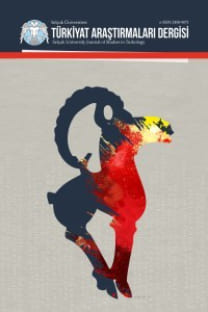"Diyâr-ı Rûm"un (Roma Ülkesi=Anadolu) "Türkiye" Hâline Gelmesinde Türk Kültürünün Rolü
Orta Çağ Türk topluluklarının hayatında, tarihin akışını değiştiren ve Türklüğün kaderinibelirleyen iki önemli tarihî olay meydana gelmiştir. Bunlardan biri, Türklerin X. yüzyıldanitibaren “Gök Tanrı” inancı ile “Atlı-Göçebe Türk medeniyeti”ni terk edip, İslâm dinine vemedeniyetine girmeleridir. Diğeri ise, XI. yüzyıldan itibaren Anadolu’yu fethedip, bu ülkeyibir Türk vatanı haline getirmeleri ve Türkleştirmeleridir. Bu makalenin konusu, birinci tarihîolayın bir bakıma doğal sonucu olan ikinci tarihî olaydır. Türklerin Anadolu’yu fethetmeleri veTürkleştirmeleri, ilk Selçuklu hükümdarı Tuğrul Bey zamanında (1040-1063) başlamış olup,1071 Malazgirt zaferinden sonra gittikçe hızlanmış ve Anadolu’da kurulan Türk Devletleri veBeylikleri zamanında da tamamlanmış ve gerçek hedefine ulaştırılmıştır. Bu arada geçen bu3-4 asırlık süre içinde, Türklerin “Diyâr-ı Rum” (Roma Ülkesi) adıyla andıkları Anadolu,nüfus ve kültür yapısıyla tam bir Türk yurdu haline gelmiştir. Nitekim, Batı dünyasının tarihyazarları, II. Haçlı seferi sırasında (1148) Türklerle dopdolu olarak gördükleri ve onların büyükbir gayretle savundukları Anadolu’ya, bundan böyle “Türkiye” (Turkhia, Turquia) demeyebaşlamışlardır. Batı dünyasının tescil etmiş olduğu bu tarihî gerçeği, Anadolu’nun eskisahibi olan Bizans da 1176 Miryokefalon yenilgisinden sonra kabul etmek zorundakalmıştır. Aynı şekilde, Batılı gezginler ve coğrafyacılar da XV. yüzyıldan itibarenDoğu Anadolu’ya “Türkmen Ülkesi” (Turcomanie, Turquemenie veya Turkomania)demek suretiyle bu gerçeği pekiştirmişlerdir.
Anahtar Kelimeler:
Türkler, Malazgirt, Miryokefalon, Oğuzlar, Anadolu, Diyâr-ı Rum, Yed Adları, Türk Dili, Millî Edebiyat
(The Role of Turkish Culture in the Conversion of “Diyar-i Rum” (Roman Land=Anatolia) into “Turkey”)
Among the lives of Medieval Turkic peoples, there have been two important historical events which changed the course of history and determined the destiny of Turks. The Turkic peoples abandoning their old belief (Kök Täŋri) and their horse-riding nomadic civilization, followed by their conversion into Islam and its civilization is one of these. The other one is their conquest, turning into a homeland and Turkicizing of Anatolia starting from the 11th century. The subject of this study is the second historical event, which is the natural result of the first one. The conquest and Turkicizing of Anatolia had begun during the time of the first Seljuqid ruler Tuğrul Bey (Tughrul Bey, Toŋrïl Beg; 1040-1063); this process speeded up continuously after the victory of Manzikert (Malazgirt) in 1071, and completed and reached its real goal during the period of Turkish states and principalities established in Anatolia. During this time period of 3-4 centuries, the land of Anatolia, called “Diyâr-i Rûm” (Roman Land) by the Turks, became a complete Turkish land with its population and cultural structure. Thus, during the Second Crusade (1148), history writers of the Western world started to use the name “Turkey” (Turkhia, Turquia) for Anatolia, which they saw as full of Turks, who defended it by all means. This historical fact, confirmed by the Western world, is also accepted by Byzantium, the exowner of Anatolia, following the defeat at Myriokephalonia in 1176. In the same way, Western travelers and geographers strengthened this fact by calling Eastern Anatolia “Turkmen Realm” (Turcomanie, Turquemenie or Turkomania) starting from the 15th century.
Keywords:
Turks, Malazgirt, Miryokefalon, Oguzs, Anatolia, Diyar-i Rum, Toponomy, Turkish Language, National Literature,
- ISSN: 1300-5766
- Yayın Aralığı: Yılda 3 Sayı
- Başlangıç: 1994
- Yayıncı: Selçuk Üniversitesi
Sayıdaki Diğer Makaleler
Eski Türk Edebiyatında Nevrûz ve Nevrûzla ilgili Unsurlara Genel Bir Bakış
Selçuki ve Osmanlı Çinileri İşçiliği
Divan Şiirinde Şehir Adlarının Tevriyeli Kullanımı Aydın-Tire Örneği
Küreselleşme Sürecinde Türk İş Kültüründe Yaşanan Dönüşümün Boyutları
19. Yüzyılda Kangal Kazası'nın Sosyo-Ekonomik Yapısına Dair
Bilge Kağan Yazıtındaki Karagan Kısıl Adı ve Yeri Üzerine Düşünceler
"Diyâr-ı Rûm"un (Roma Ülkesi=Anadolu) "Türkiye" Hâline Gelmesinde Türk Kültürünün Rolü
